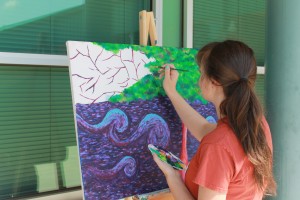
As you walk out of your math class, the stress of the day is heavy on your shoulders. You can’t stop thinking about that huge project you still have to do and that five-page paper you have to finish for tomorrow. As you reach your arts class, these feelings melt away. Perhaps it is guitar or dance. Maybe it is art or band. Regardless, it is a place where the pressure subsides. You can let go of all your worries and get into your creative flow.
Many students find solace in their arts classes. Some say that, without the arts, their day wouldn’t be worthwhile.
“I think the arts are really necessary, especially for keeping kids happy, because kids do better when they’re happy,” junior Allory Bors said. “It can be kind of crushing to have all these classes that you’re not really interested in.”
Arts teachers such as drama teacher Lori Major Carlin know the many benefits of the arts.
“[The arts] enable our students to explore themselves and explore various topics in a way that they don’t get with multiple-choice tests or in an essay,” Carlin said. “They provide our students with many opportunities for careers and for a happy life.”
Many students, like junior Danielle Santos, like the arts classes because of their creative aspects and openness.
“I like the art classes because they expand my imagination and I’m not forced to learn anything,” Santos said. “I’m not forced to memorize any vocabulary or take quizzes. I’m not limited in [arts] classes.”
The arts classes allow students to express themselves and have fun. In other classes, students might not get to do these types of things, which is why they turn to the arts.
“As I’ve gone to high school, I’ve found that, more so than middle school or elementary school, it’s really boring,” Bors said. “It really crushes your mind, almost.”
This is where the arts come into play. They allow students to have fun and find a creative outlet.
“I like guitar class because I get to compose music and perform in front of the class,” junior Shea Wood said. “I can express myself a lot easier than I would in a core class.”
Some schools are more supportive of the arts than others. Northwood seems to be in the group that favors the arts.
“Northwood seems like it revolves around the arts,” freshman Lilly Neal said.
Some of the arts teachers here, like dance teacher Leah Smith, agree.
“I think people understand how great the arts are here in Chatham County, especially at Northwood,” Smith said. “People have started to wake up and notice that the students that are involved are involved for a reason and that it’s helping them out each day. It’s getting them to school and keeping them at school.”
Still, some say that the arts are a waste of time or are “joke” classes.
“I’ve noticed a lot of the really smart kids saying, ‘Oh, well you take arts classes, so you’re not motivated,’ or something like that, and I think that’s not fair,” Bors said.
There is some controversy over whether arts classes are as important as core classes such as math and science. This might be due to the lack of standardized tests for arts classes.
“We’re not measured [grade-wise] the way that other classes are measured, and schools are held accountable to those measurements,” Carlin said. “Since we’re not included in the measurements, we’re looked at as an accessory.”
Many teachers and students believe that the arts are of the same importance as the core subjects.
“There is a lot of research out currently about how businesses and employers are feeling like creativity is the number one thing they’re looking for in the workforce, and it’s certainly lacking at this point,” Carlin said. “Students need that knowledge base, but then they need to know how to apply it, and you need to be creative to do that.”
One of the struggles of art programs everywhere is how to change the mindset of arts being less important.
“The easy answer would be to measure the arts the way that you measure other classes and to hold them accountable, but I’ve served on state committees trying to develop those tests and the arts just don’t translate to a standardized test,” Carlin said. “I think that we have to find meaningful ways to figure out if the arts are making the gains we say that we are, and there has to be some kind of assessment. I think that we have to find a way to hold the arts accountable the way that we hold other subjects accountable.”
Smith, however, doesn’t know if this problem is big enough to need a change.
“You can’t convince everybody that the arts are important, especially if they’re not an artistic-minded person,” Smith said. “When I first started teaching, I was very big on convincing everyone that my job was valid and it was worth something. But I learned that not everyone is going to agree with you. I just have to make sure that my students are convinced that what they’re doing is valuable and worthwhile, and if they’re convinced and if they feel good when they leave my class, that’s what’s important.”
— By Becca Heilman
